We do not use a whole body ice bath. This page is here for historical reference only.
A Portable Ice Bath (PIB) has been used by other cryonics organizations to contain the patient and the ice during initial stabilization and cooldown to zero C. It must be able to safely move the heavy unstable load and must be easy to load into the transport vehicle. Each cryonics organization designs and builds their own ice baths to match their own unique needs.
PIB 1
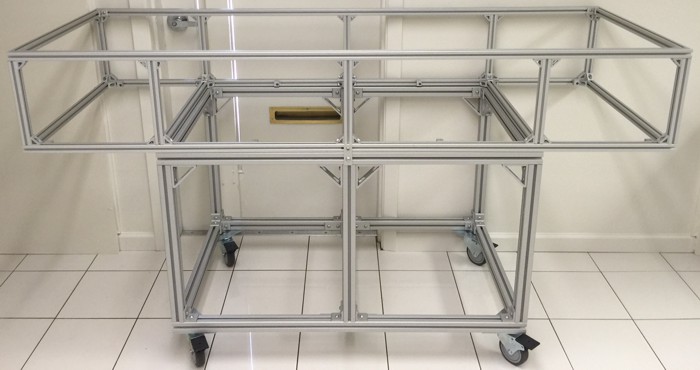
Built from 1 1/2" and 1" extruded aluminum from www.8020.net. External dimensions of the bath portion are 27" wide, 12” high, and 75” long. Internal dimensions are 25" wide, 11” high, and 73” long. The leg section raises the ice bath to 30".
Construction details are on the Ice Bath Parts page.
PIB 2
Made from square aluminum tubing.
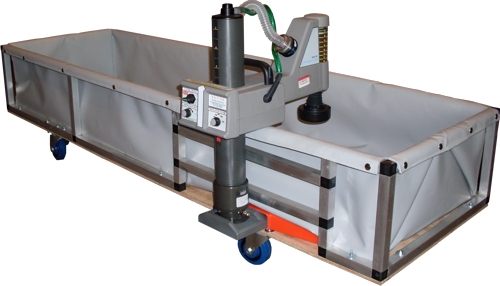
It rides low to the ground for stability. It was designed to allow easy mounting and positioning of a model 1007 Thumper. 1" aluminum tubing with 1/16" walls is used throughout. Anodized aluminum would give a cleaner look but would also cost more. The external dimensions are 73" long, 22" wide, and 11" deep, excluding the wheels and Thumper. Internal dimensions are 71" long, 20" wide, and 11" deep. There is no horizontal bar hidden by the top fold of the liner in the area of the Thumper.
The joints use these connectors from eztube.com:
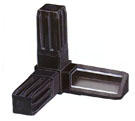
The connectors have welded steel cores with ABS/nylon jackets. They come in a wide variety of orthogonal configurations. The entire ice bath frame was simply hammered together and is amazingly strong. On the side where the Thumper is mounted, the connectors had to be cut with a large grinding wheel because they were too long for such short lengths of tubing. This could be avoided in the future by only using one horizontal tube in that area. The tubes themselves were cut with a circular miter saw using a plywood blade. Some aluminum debris needed to be removed from the teeth after a dozen or so cuts. The plywood base is only 3/8" for lightness, and there are no horizontal supports under it. There are a number of things that could be done to improve support under the plywood, including a second aluminum box structure for the wheel assembly, or even a simple tube bolted under the plywood. Where the plywood is bolted to the aluminum frame, fender washers were used. The liner was made with reinforced 18 oz. vinyl of the kind commonly used to make tarps and covers for big trucks. It is a single piece, origami folded at the corners to avoid seams under the water level. The tent and awning company built the liner for $100 total for all material and labor. They also installed all the snaps, using screws with snap heads that easily screwed into the tubing.
Quick load calculation: For the calculation, we will assume that the ice bath will be filled with a patient and water to a depth of 7" (it would be less in reality), the total volume of water would be 7*71*20=9940 in3 or 5.75 ft3. At 62 lb/ft3, the total weight would be 356 lbs. The mechanical stress of the Thumper need not be included because that is handled by the backboard. Subjectively, the plywood seems strong enough to support this weight. It can support a 150 lb person gently bouncing on one concentrated point in the middle. A better test would be to fill it with water. The Portugal group built a nearly identical ice bath which failed when filled with water, but their backboard was described as collapsible, implying that it was not a solid sheet of plywood like the one above.
There will be lifting straps or webbing that goes in under the patient in order to allow lifting out of the ice bath later.
PIB 3
Welded from stainless steel. Completely collapsible to allow carrying as checked baggage. The leg section is optional.
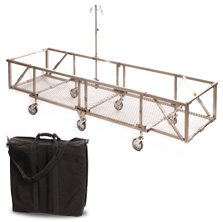
Examples from Other Organizations
Here are some examples of ice baths which have been designed by other cryonics organizations.
A typical plywood base and PVC pipe frame:
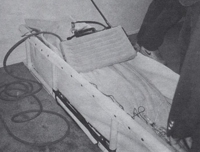
Alcor ice bath folds in half clamshell style for air transport:
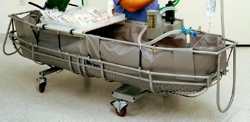
Alcor Mobile Advanced Rescue Cart (MARC), no longer in use, has a welded steel frame:
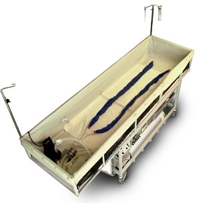
Used by Cryonics Institute, built by Suspended Animation, stainless steel with collapsible legs:
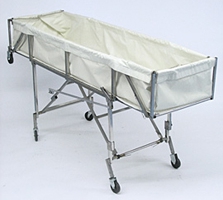
Design considerations
There are many possible ice bath designs, and we will have a variety of ice baths for different purposes. The design considerations below are NOT all for a single ice bath:
Lucas: A Lucas (which we have) or a Lucas II (which we might obtain some day) sits fully within the ice bath. It pushes on the chest and also pulls on the upstroke using a suction cup. This increases the efficiency of the cardiopulmonary support.
Head ice bath: Sits inside the main ice bath and allows concentrated cooling of the head without large amounts of ice. We have already built this.
Base material: Plywood is not a good material because it cannot be decontaminated. Smooth sheet stainless steel or aluminum or expanded mesh with proper support is a better choice. Polypropylene is a good lightweight choice. The wrong kind of plastic can become brittle and break when cold. 18 or 20 gauge 1" hexagonal wire mesh coated with vinyl is used in some lightweight commercial stretchers.
Water circulation: Keeps the water moving on all body surfaces to improve cooling. Uses battery operated pump.
Drain: This is commonly done by incorporating a valve and extra hose into the water circulation system. The pump can then be used to pump extra water into a nearby container or sink.
Insulation: A double walled liner with wool batting or foam rubber between the layers can help prevent the ice from melting so quickly. It also helps reduce condensation on the exterior of the liner. A camping mat can be used under the patient.
IV pole: If the patient already has an IV, it is best to leave it in place in order to deliver medications postmortem. A pole then becomes necessary.
Foldable for air transport: Very compact. Fast to assemble on site.
Low-riding: Used when the transport vehicle has limited height, when cost and time preclude building legs, or when it needs to fold for air transport. This style of ice bath needs to be elevated for surgery by moving to a table or placing on sturdy saw horses. This frequently makes it too high, requiring people to stand on stools for access.
High-riding with folding legs: Looks more like a standard stretcher. Height is good for surgery, and also fits into a vehicle with less headroom. Building the legs is fairly complex.
High-riding Cart: Strong and sturdy. Height is good for surgery. Extensive equipment can be built into cart under the ice bath. Requires a truck with a lift and plenty of headroom. Probably too heavy to move down stairs while loaded.
Reconfigurable: Legs that fold or can be removed. Wheels that quickly attach directly to bath for low riding configuration.
Different sizes: Extra wide and sturdy designs. Or extra long designs.
Maneuverability: To allow going around tight corners and fitting in small elevators, ends should be tapered. Foot end could fold upwards.
Wheelbase width: Ramp widths vary significantly, between 23" and 28". There have been incidents in cryonics where the wheelbase was wider than the ramp of the rented vehicle. The only solution was to quickly purchase plywood and lay it on top of the existing ramp.
Hoists: The baths can be very heavy. Cranes, winches, hoists, lifts, etc all make handling the weight easier and safer, especially if few people are available. A lift has failed on at least one cryonics case.
Design limitations
Over the years, a wide variety of ideas have been tried by various organizations. Some of them just didn't work very well for one reason or another. Some of the ideas listed here are actually currently in use. But the disadvantages must be carefully considered before using.
Plastic pipe: Base made of plywood. Frame for liner made of 2" PVC pipe. The problem is that the ice bath cannot be lifted by the pipe framework because it's not strong enough, especially when cold. This design is still sometimes used due to low cost.
Spray heads: They cause splashing, which is a biohazard. Any water circulation device must be properly diffused.
Solid walls: Nobody has ever built an ice bath with solid walls. Plywood might be too heavy. Fiberglass, plastic, or sheet metal might work. But it would be difficult to ensure that a large solid design with seams would be watertight. Most importantly, the additional weight would make lifting more difficult and dangerous.
Ramp: To roll a heavy ice bath into a vehicle. This is a low cost option that is sometimes used instead of a lift. It never works well, but is a last resort on a rental vehicle or a lift failure. The steeper, the longer, and the narrower the ramp, the more impractical it becomes. The water must all be drained out, and enough people must be present to do it safely. It has been taken to extremes, where an electric winch was used to pull the cart up the ramp, and a leveling jack was used to prop up one end of the cart. It can become a complicated and dangerous technique. Ramps can be fabricated on site out of wood, or plywood can be used on top of an existing metal ramp to widen it.
Ambulance cot: The wheelbase is too small and the center of gravity too high. It becomes tipsy, and one small shift can cause the water filled bath to suddenly lurch dangerously. Also, older small wheels do not handle irregularities like door thresholds very well.
Autopulse: The Autopulse is a mechanical CPS device which lies under the patient. It uses batteries to power a motor that pulls on a strap extended around the patient. Due to the ice bath, this seems like an unworkable idea for cryonics. Attempts to adapt it to work with an ice bath have resulted in water damage to the device. Even the condensation that is always present when using an ice bath can render the device useless. However, Suspended Animation seems to have overcome these obstacles and an Autopulse is their current choice of CPS device, having been used in at least one case.
